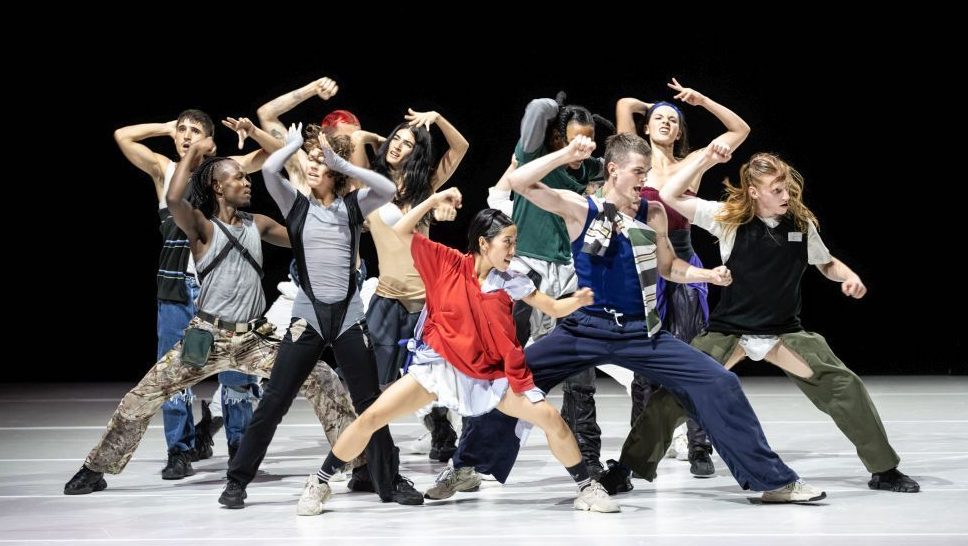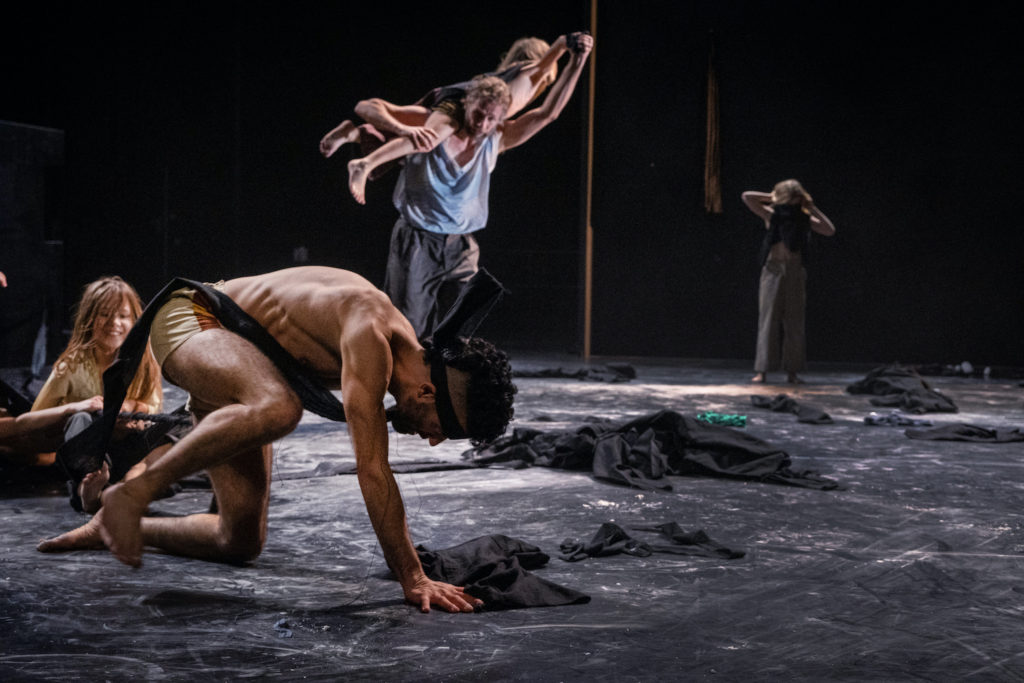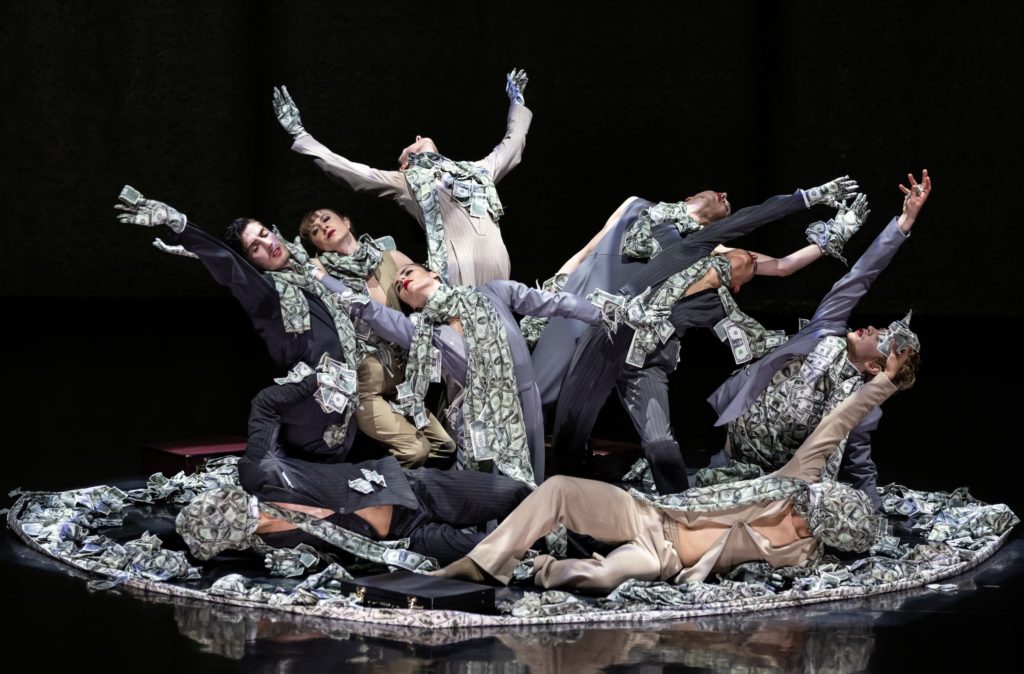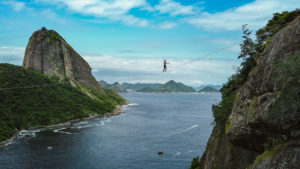Venice and Bolzano: Festival season, summer 2022 - Vancouver Ballet Society
- Home
- City Reports 2020 - 2023
- Venice and Bolzano: Festival season, summer 2022

By Silvia Poletti
Bolzano Danza and Venice Biennale Danza — the two most important events of the Italian summer, with overlapping dates that make attending both a challenge — were branded this year around similar thought-provoking themes. Under Wayne McGregor’s direction for the second year, the title of this year’s Venice program was Boundary-less, while Bolzano Danza, which starts first, chose the theme No Limits.
Bolzano Danza’s program featured extraordinary physical challenges that included the French highliner (tightrope walker) Nathan Paulin’s crossing of the Forcella Sassolungo, a narrow mountain pass in the Alps at 2600 meters altitude, not far from Bolzano, in French choreographer Rachid Ouramdane’s Les Traceurs. A spiritual side to No Limits was evident in Ouramdane’s mystic Dans le noir on voit mieux, created for Lora Juodkaite to evoke a shaman’s practice. While the professional dancer whirls, we hear the shaman’s voice telling her own story of finding spiritual powers.

A common basis to all the works was the energy that fuels action and spreads emotion. The French collective (LA)HORDE definitely uses dancers’ energy for expressing their vision of the world. An artist collective of three, (LA)HORDE currently leads France’s Ballet National de Marseille, founded by the celebrated choreographer Roland Petit in 1972. Under the collective’s direction, the company is becoming the perfect embodiment of the younger generations’ angst-filled tensions and determination to pursue their right to live in a better world. Diversity in unity could be the claim of the Ballet National de Marseille’s artistic manifesto, emphasized by dancers who come not just from the ballet world, but from styles as varied as hip hop and martial arts.
In the acclaimed six-part Roommates, these diversities were proudly displayed. It seems (LA)HORDE’s artistic co-directors — Marine Brutti, Jonathan Debrouwer, and Arthur Harel — do not forget that the Marseille company is a national institution with deep roots in the traditions of choreography: Roommates celebrates the legacy of artists they consider influential in their own creative progress. This included American postmodernist Lucinda Childs and French Nouvelle Danse choreographer Claude Brumachon, whose works were performed with a fresh sense of attack, not stylistically flawless but lively and unaffected.

I was puzzled after viewing promise me by the Flemish group laGeste, a joint venture between kabinet k and les ballets C de la B. In an overwhelming explosion of unrestrained energy, two men and five incredible girls aged 10 to 13 demonstrate with fierce stamina some of the physical ways of performing on an empty stage. The girls incessantly climb onto the backs of the men; they free fall in the men’s arms and rush downstage, shouting out and throwing pieces of their costumes toward the spectator. LaGeste co-director Joke Laureyns explained in a talk after the show that the piece was born from improvisations after the lockdown. But the work’s virulent energy surely cannot be only a tribute to re-found freedom.
A more reinvigorating energy, one that makes you want to stand up from your chair and dance, drives Ohad Naharin’s Kamuyot (2008), performed by the empathic dancers of Eric Gauthier Dance Company. Montreal-born Gauthier and his Stuttgart-based group, who are regulars at Bolzano Danza, this year also appeared at the Venice Biennale, a three-hour train ride away.
In Venice, Gauthier Dance premiered its major production, The Seven Sins, with choreography by seven of the most relevant choreographers of our time: Sidi Larbi Cherkaoui (Greed), Aszure Barton (Sloth), Marcos Morau (Pride), Hofesh Shechter (Lust), Marco Goecke (Gluttony), Sasha Waltz (Anger), and Sharon Eyal (Envy).

In the pre-show talk, Gauthier suggested that audiences consider each piece one part of a whole mosaic, together creating one picture, but each dance was so peculiar that it was impossible to do this. Three sections most impressed this viewer: first, Morau’s strong theatrical concept for Pride, where aggressive sounds and whipping lights frame the rigorous gestures of five women in blue, recalling the ancient matriarchy of his homeland, Spain. Goecke’s idiosyncratic style with frantic arm gestures and pulsating breath evoked Hunger for dancer Gaetano Signorelli’s rock-star character. Barton, with her usual humour, cleverly presented Sloth in slipping, lazy, but somehow also precise gestures in a male duet.

Dance is the pivotal centre at the work of the Golden Lion for Life Achievement award-winner Saburo Teshigawara, a Japanese choreographer, visual artist, and lighting designer whose mise-en-scène tends to simplicity, and yet can carry such emotional intensity. At Teatro Malibran, he presented the world premiere of his Petroushka, going deep inside the poetic essence of Fokine’s ballet to create a dramatic soliloquy for himself. His solo is interrupted for few moments by the elusive appearances of the Ballerina character, danced by Rihoko Sato, as pale and cool as the moon. The clever remix of Stravinsky’s score helps Teshigawara to express sorrow, rage, and loneliness with his razor-defined gestures, one more making the tragedy of Fokine’s iconic puppet human and universal.
The Venice program resounded with a call for social relevance through powerful productions like the impressive Jurrungu Ngan-ga (Straight Talk) by the Australian Indigenous group Marrugeku. The work denounces the Australian prison system for its high levels of incarceration of Indigenous people, connecting this to the country’s lengthy detaining of asylum-seekers.
The Venice Biennale was also important for Italian dance, with an earlier call for submissions for an Italian premiere to be produced by the Biennale. The winning commission went to Diego Tortelli, a choreographer on the rise with several collaborations with Aterballetto and independent projects in Germany. Tortelli has his own recognizable vocabulary — impersonal, cold, disjointed — and he loves to find connections between dance and technology. His Fo:No started from the idea of transformation: how a body reacts physically and psychologically to vocal cord surgeries that change the sound of the voice, which Tortelli investigates through movement set to the percussive sounds of beatboxing. Unfortunately, the concept was hard to understand in a choreographic structure that repeated his well-known use of fragmentation — of bodies and movement — without really revealing anything more about his theme.

